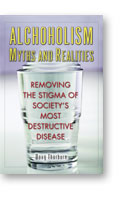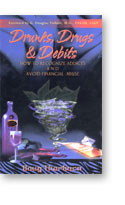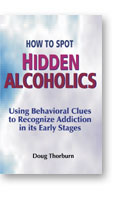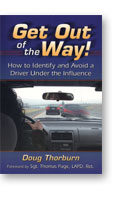 |

|
Welcome to the Thorburn Addiction Report. Each month, we bring you several sections, including:
1. Top Story of the month
2. Movie or Book Review of the month
3. Dear Doug in which a recent letter to "Dear Annie" or other "help" column is rewritten, with responses given from the unique perspective that alcohol or other drug addiction best explains the misbehaviors described
4. Alcoholic Myth-of-the-Month
5. Alcoholic Antic-of-the-Month
There is something for everyone!
|
|
|

Doug has been busy adding to his blog over the last couple of months. There are some interesting letters and notes on power trips and alcoholism, Vernon Blake of the Alabama Dept. of Transportation (fired over whistleblowing, with likely addicts all around him -- my opinion), repressed memory syndrome and an “I am always right” attitude among some libertarians (engaging in power-seeking behaviors of the mind). You can easily search for various topics using the “search” function on the blog page at www.preventragedy.com/worldpress/. If you have a topic you’d like to see addressed on the blog, send me an email (the link for which is near the bottom of this month’s report). Now for the news!
Thorburn blog
|
|
| It’s time to narrow the focus of the war on drugs

Top Story: Everyone suffers from the war,
except the drug lords
“Prohibition is an awful flop. We like it.
It can’t stop what it’s meant to stop. We like it.
It’s left a trail of graft and slime,
It don’t prohibit worth a dime,
It’s filled our land with vice and crime.
Nevertheless, we’re for it."
—
Franklin P. Adams (1931)
Hoping to appease a violent minority of coca farmers organized by Evo Morales, two Bolivian presidents have stepped down from office in two years, the latest in June. In a seemingly unrelated development, also in June, police Commander Enrique Cardenas, responsible for policing the Mexican town of Nuevo Laredo across the border from Laredo, Texas, was murdered in front of his nine-year-old daughter. Two weeks later, Alejandro Dominguez, proclaiming “I’m not afraid of anyone, and I don’t owe anybody anything,” was sworn in as Cardenas’ replacement. Six hours later he, too, was dead, his body riddled with bullets. What do unstable governments and horrific deaths such as these have in common? The war on drugs.
Joseph D. McNamara, the outspoken research fellow at The Hoover Institution and former Kansas City, Mo. and San Jose, Ca. chief of police, notes that efforts at eradicating the production and distribution of currently illegal drugs suffer from a “sausage effect.” As he puts it, “squeeze one end, the other end expands.” Just released United Nations figures show $5.4 billion spent on drug eradication in Latin America has done nothing to decrease availability of cocaine in the U.S. Coca cultivation in the Andes instead increased by 2% in 2004. This should not be surprising. And, to the extent that there was a temporary measure of success in reducing coca cultivation in the late ‘90s, methamphetamine use has skyrocketed. After all, if addicts can’t get cocaine, they’ll use meth, even though it is a far more destructive drug.
And yet, U.S. federal drug czar John P. Walters told Congress in June, “We are winning” the war on drugs.
McNamara grasps the idea that it cannot be won. Further, he understands the basic economics of criminalizing use. He points out that decriminalization would lead to dramatically reduced profits and far more civilized behaviors on the part of drug providers. The shareholders and corporate captains of Jim Beam, Jose Cuervo or Corona and, for that matter, the makers of Oxycontin and Vicodin (legal forms of heroin) have never forced a President from office or gunned down a law enforcer (or anyone else). Nor have they ever paid others to do so.
Worse, extraordinary profits accrue to those willing to take enormous risks from criminal enterprises, which is particularly disconcerting in an age of terrorism. These are typically people you wouldn’t want to run into in a dark alley or trust with a nuclear weapon. Because alcoholics tend to take far greater risks than others, the odds are excellent that people involved in the drug trade, particularly at the top, are highly functional alcoholics. Since practicing alcoholics are capable of anything -- including terrorism -- we can predict that prohibition might increase national security concerns. North Korea’s ruler Kim Jong Il may at some point provide us with proof of this. At the very least, part of the cost of doing business in an illegal enterprise is funding violence and payoffs needed to secure turf and protection from law enforcers. One consequence is corruption on an unimaginable scale. When Mexican President Vicente Fox sent federal agents to Nuevo Laredo after the second top-cop murder, some 40 Nuevo Laredo law enforcers fired upon them, providing clear evidence of the connection between the drug trade and local police.
By criminalizing the drug rather than the person on the drug who acts badly, we deny the right of ownership and abrogate responsibility. The drug war cannot be won by focusing on drugs, but instead on the behaviors of addicts and, when society can connect use and misbehaviors, by coercing abstinence. This requires a new paradigm: we need to narrow the focus of the war on drugs.
Runners-up for top story of the month: Russell Crowe, whose wife Daniell Spencer had already asked him to stop drinking because it “seems to make him so aggressive,” assaulting a New York hotel employee with a phone and blaming it on “jet lag, loneliness and adrenaline.” He explained that he was trying to call his wife to let her know that “I’m at home, I’m in bed, I haven’t had too much to drink and, primely important, that I’m alone.” At 4 a.m. He wore very dark sunglasses as he was escorted out in handcuffs. At 4 a.m. (A week later he was spotted joking about the incident -- while drinking at a Canadian pub.) Nineteen-year-old Sydney Simpson, following in her famous father’s footsteps, reportedly seen partying “hard” during spring break. Lindsay Lohan’s father Michael Lohan, sentenced to prison after pleading with the judge to send him to rehab; it’s unfortunate that the two are rarely combined. Pop singer Michael Jackson, acquitted on all charges of child molestation, back to the business of preventing his finances from falling into further disarray with the help of the Rev. Jesse Jackson, attempting to negotiate with lenders on his behalf.
Known gang member Jose Luis Orozco, allegedly murdering Deputy Jerry Ortiz at point blank range while while he was searching for Orozco. (The tragic story is detailed below in “Alcoholic Myth-of-the-Month.”) Former nanny Jimena Barreto, sentenced to 30 years to life in prison for running down Troy Pack, 10, and his sister Alana, 7, while under the influence. Previously convicted four times for DUI, she was seen drinking the day of the crash. Barreto, who got down on her knees in court and begged for forgiveness, sobbed as she read a two-page apology to the parents, in which she admitted taking a prescription painkiller and a muscle relaxant the day of the tragedy, but denied she was drinking. Based on averages, Barreto, who is 46, was legally under the influence while behind the wheel of a car about 2,400 times. Therefore, there were 2,400 instances of misbehavior for which the law could have appropriately and uncompromisingly intervened, but didn’t. Marcus Wesson, convicted of the March 2004 murders of nine of his children in cult-like fashion in Fresno, California and sentenced to death. The son of a known alcoholic, Marcus worshiped both Christ and vampires and consummated “marriage” with some of his children. The possible culprits in the disappearance of Natalee Holloway after a night out at Carlos’n’Charlie’s on Aruba, particularly the “hard drinking, violence-prone” Joran van der Sloot, who is reported to party every weekend and pick fights while drinking “for no reason at all.” Unfortunately, if there are tracks, alcoholics can be superb at covering them. Toby Whelchel, who had a history of volatile misbehaviors for which close people and the law were given numerous opportunities to intervene but didn’t, killing himself after a murder spree through Thousand Oaks and Simi Valley, California, in which three others were murdered. His 1 1/2 page rap sheet began in 1990 with an arrest for assaulting a police officer and disorderly intoxication. Investigators, “trying to figure out what set him off,” said he went on the rampage for “reasons that remain a mystery.” They didn’t seem to grasp the idea that alcoholics don’t require anything in particular to incite them to extraordinary violence. My article on the tragedy was published in the op-ed section of the Los Angeles Daily News on June 17 and is on my blog at www.preventragedy.com/worldpress/ (use the “search” function for “Whelchel”).
Former America West pilots Thomas Cloyd and Christopher Hughes, found guilty of being drunk in the cockpit after drinking all night at a sports bar (the story’s beginnings can be found on page 71 of Alcoholism Myths and Realities). Prizefighter Mike Tyson, sitting down in the 4th round and ceding the fight to Kevin McBride, reportedly $34 million in debt after blowing $400 million in gross income over the course of his career on jewelry, women, partying and mansions. Tyson, who watched multiple boyfriends beat up his alcoholic mother until she died when he was 16, may have hit bottom. Liza Minelli, crediting her six months of sobriety to religion and daily attendance at AA meetings, claiming alcoholism “has never ever affected a performance or stood in the way of my work.” Yet, she had hardly worked in years and was out of control, broke and battling “vicious” lawsuits from ex-husband David Gest and former assistant M’Hammed Soumayah, who both allege assault. Kelly Osbourne, admitting she started using opiates at age 13 and was continuously high while filming “The Osbournes” and recording her debut album, now writing songs about “so-called friends not stopping” her doing drugs. Her addiction surfaced only when she was photographed a year ago at age 19 buying drugs after six years of non-stop use, at which point her parents forced her into rehab. (W.C. Fields had a similar problem -- except that not only did his “friends” not stop him from using, but instead smuggled gin into the sanitorium in which he resided even after doctors forbade him from drinking due to cirrhosis and kidney disease. He died a few months later.) And, a slim Jack Osbourne, Kelly’s 19-year-old and one-year sober brother (off everything, including his drug of choice, Oxycontin), doing an extreme sports show for British TV, which includes mountain climbing, bungee jumping and kick boxing. Hey, anything to stay sober.
Under watch: New York Attorney General Eliot Spitzer, finally confronted in the courtroom by one of his business targets, former Bank of America broker Theodore Sihpol, in a match reminiscent of David and Goliath. The jury found Sihpol’s after-market-close trading, which Mr. Spitzer called criminal, to be commonly accepted practice. Sihpol was acquitted on 29 counts, with the jury hung on four others, for which a single juror held out for conviction. Sihpol had refused a plea offer that included jail time, putting himself at risk for a 30-year term. Other business targets have caved into Spitzer’s prosecution-by-press-release and threats of indictment or the destruction of an entire company, paying enormous fines (often with shareholder funds). None had previously risked a trial. Alberto Vilar, former patron of the arts and investment adviser, co-founder of Amerindo Investment Advisors Inc., arrested on charges of fraud and money laundering. Vilar, who spent big, lived high, made grandiose promises of bestowing charitable gifts and whose firm once managed $7 billion, reportedly now has no money and owes the Internal Revenue Service $24 million. The week he was arrested, he had boasted he was planning to take a close friend to Paris for his birthday and dine in London on the way back with Prince Charles. While blaming a series of back surgeries that left him bedridden for missing charitable pledges to hospitals, universities and opera houses, he admitted to taking 16 different medications for dislocations in his back. His Amerindo Technology Fund, a stock mutual fund, is down about 80% from its 2000 peak.
Dean Arthur Schwartzmiller, whose notes in binders detailing hundreds of child molestation victims over a 30-year period were found by police; there were 36,720 entries in seven binders categorized by age, willingness to engage in sex acts and types of acts. Schwartzmiller’s roommate, Fred Everts, was also charged with molesting children. Rep. Randy “Duke” Cunningham (R-San Diego), under investigation, no doubt for graft, by the FBI over the sale of his Del Mar Heights home in November 2003 for $1,675,000 to Washington-based MZM Inc., a defense contractor, which put the house back on the market the following month. They sold it for $975,000 seven months later, a loss of $700,000 in the midst of a booming real estate market. The House Republican leader, Rep. Tom DeLay of Texas, defended Cunningham as “an honorable man with high integrity.” Cunningham, an eight-term member of Congress, sits on the Defense Appropriations Subcommittee. Ventura County Senior Sheriff’s Deputy Patrick J. Dain indicted for allegedly filing false income tax returns from 1994 to 2000 on which he reported zero wages, and for threatening an IRS auditor who had levied his wages. Riverside County Sheriff’s Deputy Efrain Santos, Jr. , charged with five counts of spousal and child abuse, along with criminal threats against his live-in girlfriend and 4-year-old daughter; he is also under investigation for allegedly using excessive force in an arrest. Kathy Trant, whose husband died in the 9-11 attacks at the World Trade Center and who was showered with some $5 million from the government and well-wishers, admitting she is down to her last $500,000 after tripling the square footage of her house, adding a pool, hot tub and a full-size basketball court, filling her wardrobe with expensive fashion items costing her a half million dollars and squandering $70,000 taking a group of friends to the Super Bowl. After the terror attack, she admits to having been “beset by depression, drinking and a body weight that yo-yoed between 90 and 170 lbs.,” and says she spent to alleviate the pain. Claiming her life has been wrecked again -- this time by money -- she might want to take a look at the role that “drinking” may have played in her compulsive spending, eating disorders and depression.
Note to family, friends and fans of the above: the benefit of the doubt is given by assuming alcoholism (they are either idiots and fundamentally rotten, or they are alcoholic/other drug addicts -- which would explain the misbehaviors). If alcoholic, there is zero chance that behaviors, in the long run, will improve without sobriety. An essential prerequisite to sobriety is the cessation of enabling, allowing pain and crises to build. Thus far, many have done everything they can to protect the addict from the requisite pain, making these news events possible. The cure for alcoholism, consequential bad behaviors and, ultimately, tragedy, is simple: stop protecting the addict from the logical consequences of the misbehaviors and proactively intervene.
Thorburn Substance Addiction Recognition Indicator
|
The war on drugs allows the worst to create untold wealth
|

Movie Review: "Batman Begins," "A License to Kill," and "Traffic”
You wouldn’t think a comic strip hero, James Bond and a movie about drug trafficking would have something in common. Yet each, in its own way, reinforces the idea that illegality creates high prices not only worth killing over, but also untold billions for those willing to take extraordinary risks.
The biggest risk-takers are alcohol and other drug addicts. Distortions of perception cause impaired judgment. In particular, the addict comes to think he can do no wrong, which creates a sense of invincibility. A “rules don’t apply to me” attitude often becomes all-pervasive. This can be observed in many addicts that, no doubt, permeate the drug trade.
"Batman Begins" starts out with the future Batman witnessing his parents’ murder. While some might believe the murderer was desperate for food, we see the eyes of an addict, stealing so he can get sustenance in the form of drugs. The particular story is one in which the chief drug runner, Falconi, has bought off everyone in Gotham politics who matters, including one full-blown addict judge. A weaponized hallucinogen is ferreted in the usual drugs. The fact that they weren’t smuggled in toys or alcohol suggests that the illegality provided the funds and means to support criminal behaviors, which included incomprehensible levels of corruption.
The shareholders of Coors and Diageo (the world's largest distillery) can only wish they had that kind of money. In fact, it’s interesting to contemplate the anger some have over the advertising and lobbying costs incurred by the big alcohol producers. The anger would be more appropriately targeted at drug laws, which allow really bad people to become wealthy beyond our dreams and fuel corruption among law enforcers.
In "License to Kill," James Bond (played by Timothy Dalton), in an effort to avenge a friend’s murder at the hands of drug lords, stumbles onto what could easily be a billion dollar drug complex in Latin America headed up by a drug lord played by Robert Davi, who exhibits real-life behavioral indications of alcoholism (I’ve seen him throw fits at a Starbucks near my home in Northridge, CA). His cronies include characters played by Anthony Zerbe and a young Benicio Del Toro. The movie, although other critics seem to have never noticed, may be the best argument ever on the big screen for ending the war on drugs.
"Traffic," starring Benicio Del Toro, Michael Douglas and Catherine Zeta-Jones and based on the British made for TV movie, "Traffik," shows the U.S. drug czar transform from a war hawk, nominated by the President to reinvigorate the drug war, to someone who begins to slowly understand the meaning of the departing drug czar’s comment that years of effort have had no effect on the drug trade. When he discovers his own daughter is an addict, he does everything to protect her from the law and asks, in a scathing indictment of the drug war, “How [can] you wage war on your family?”
All three movies are highly recommended not only for their entertainment value, but also for those who think the war on drugs as we know it should continue to be fought.
|
 |
Dear Doug: Party-hardy momma
Dear Doug:
My mother owns a successful business, but she’s hanging out with a crowd of divorcees who drag her to bars. We share a car and I suspect her of smoking, which she denies. After dad leaves for work at night I see mom doing a lot of drinking. When I confront her about my concerns, she makes up excuses and goes further to hide her problems and booze. I’m told that people abuse alcohol because they are depressed, but we had a great family life until recently. What do you suggest I do?
Signed, Concerned Daughter
. . . . . .
Dear Concerned Daughter,
Other columnists might suggest that while your parents need professional help, you should talk to a school counselor or adult relative you can trust to provide emotional support and help you express your concerns to your parents. However, you have already seen how far such expressions got you.
Your mother’s friends are able to “drag” her to bars because she has the disease of alcoholism. She has been able to control the drinking and deterioration in her personal life because she has, until now, successfully inflated her ego through her success at work. However, as the disease progresses and neurotransmitter activity in the brain begins to falter, she will become increasingly less able to do this and more obvious in her affliction. Those who have told you that people abuse alcohol because of depression have cause and effect reversed. Instead, alcoholism causes a deterioration of family life and, oftentimes, what appears to be Depressive Personality Disorder. While the odds that she is smoking as you suspect are 90%, that is a far lesser concern than her alcoholism. Besides, she will not be able to quit smoking until she stops drinking.
All of your efforts should be concentrated on helping your mother experience the logical consequences of her misbehaviors. The possibilities are endless and dependent upon circumstances, but must be carefully synchronized with a professionally-aided intervention. For an intervention to work, you, your father, and everyone else close to your mom need to understand alcoholism. Only then will your mother’s enablers stop protecting her from consequences and allow her to experience pain, improving the odds that intervention will get her into rehab, giving her a chance at long term sobriety.
(Source for story idea: Annie's Mailbox, May 28, 2005.)
|

Alcoholic Myth-of-the-Month: It’s the families’ fault
“The family can do more than the law in stemming drug use.”
“I’m going to continue to make a hard run at the families of these gang members. You are responsible, partially, for the lack of help your child gets.”
So said Los Angeles County Sheriff Lee Baca, stepping up his pressure on parents to take responsibility for their children in the wake of the cold-blooded murder of Deputy Jerry Ortiz, allegedly by known gang member Jose Luis Orozco.
One of the more obvious problems with this is that Orozco is 27. His parents, described as “religious and hard-working” by a former neighbor who was “offended” by Baca’s remarks, moved to Las Vegas two years ago to get away from the neighborhood.
Another is that relatives of those charged with crimes are not allowed to stand in judgment in the jury box for good reason: they typically will not vote to convict, regardless of the evidence. Families, in other words, are not good at offering tough love in uncompromising fashion and at imposing logical consequences on the perpetrator, particularly as the crime worsens. At some point, the law needs to step in to perform this function.
Sheriff’s Department Homicide Bureau Capt. Ray Peavy said there wasn’t much more authorities could have done to prevent the tragedy. Yet, Orozco’s rap sheet spanned more than a dozen years and reportedly included arrests in four counties for vehicle burglary, assault with a deadly weapon, floating bad checks and possession of cocaine and marijuana. He had not been in contact with his parole officer since January, after serving time for a weapons violation.
I asked several former gang members at an addictions conference earlier this year what percentage of gang members were alcoholics. Their estimates were, in every case, 100%.
Note to Capt. Peavy and Sheriff Baca: the criminal justice system could have done far more to prevent this tragedy. While there’s nothing wrong with parents doing what they can to intervene in the lives of young addicts, the rest of us cannot count on them doing so. The law has the excuse to intervene and the means to effectively do so by coercing abstinence. Recovering addicts don’t act like ruthless animals and murder people.
|

Amazing Antics: Stories of Alcoholism-Driven Behaviors™
Just what was the officer thinking?
"THE GLAMOROUS SIDE OF DRINKING: A trooper investigating a single-car accident in Woodville, Maine, says that driver Peter Bradley Murray, 42, appeared intoxicated and had urinated on himself. But he could still see straight. "He said, 'You have beautiful green eyes,' and he started touching my arm," State Trooper Jennifer Fiske said. She started to handcuff him, but only got one side on when he pulled away and tried to lock her in the other cuff, saying "I just want us to be tied together." She whacked him with her baton and finished cuffing him. "What did he think I was going to do? Go out on a date with him?" (Bangor Daily News) ...Apparently he misunderstood when she said he'd get a 'date in court.'"
Columnist Randy Cassingham merely touched on the full story, which is a true humdinger on a variety of levels. Murray had already allegedly failed three roadside sobriety tests and refused to take another. Because Fiske’s police cruiser was not equipped with a cage separating the front and back seats, she sat Murray in the front passenger seat. Although friendly (yeah, I’ll bet) and cooperative during the tests, he began to behave “inappropriately” when he got into the cruiser. It was only at that point that she attempted to handcuff him. Just what was she thinking when she put an alcoholic in the front seat, unrestrained? The consequences could have been far worse.
With handcuffs on, Murray continued to make attempts at touching her and, at one point, made a grab for the steering wheel while en route to her station. Another officer rode with her from the station to the county jail, adding leg restraints to the already handcuffed Murray.
Fiske said, if she could do it all over again, she’d “probably” handcuff the suspect before sitting in the police cruiser with him, “but at the time he was behaving well.” Fiske, like so many law enforcers, has failed to grasp the key behavioral abnormality of alcoholism: that we cannot predict how destructive the behaviors of a practicing alcoholic may become, or when. She also rationalized that Murray must have had a very bad night. No, State Trooper Fiske: Murray was having what was likely, for him, a common night: drinking, no doubt way beyond the legal limit, getting behind the wheel of a car and, in other ways unfathomable to the non-alcoholic, acting badly.
And, a bonus antic:
"THE GLAMOROUS SIDE OF SMOKING: Jeff Foran, 38, was too drunk to drive, so he asked a friend to give him a ride home. On the highway along the Arkansas-Oklahoma border near Foreman, Ark., a gust of wind blew Foran's cigarette out the window, so he jumped after it. The car was going 55-60 mph. Foran suffered "a substantial case of road rash," said State Police Trooper Jamie Gravier, mainly on his face. "If anything could make him stop smoking, this should be it." (Texarkana Gazette)...Actually, dying is what usually makes people stop smoking."
Another State Trooper doesn’t seem to grasp the idea of alcoholism. How about, more accurately, “if anything could make him stop drinking, this should be it?” The Trooper implies that the cigarette made him jump; no, Trooper Gravier, alcoholic distortions of perception and memory leading to impaired judgment, manifesting in a sense of invincibility, is usually at the root of idiotic risk-taking behaviors.
(Stories from “This is True,” copyright 2005 by Randy Cassingham, used with permission. See http://www.thisistrue.com for free subscriptions.)
|
Comments
To view reader's comments on last month's Thorburn Addiction Report and Doug's responses please visit the Thorburn Weblog at PrevenTragedy.com.
Doug frequently posts alcoholism-related articles, as well as his responses, so be sure to check back often.
Thorburn Weblog
|
Doug's new book, Alcoholism Myths and Realities, is available pre-publication to
our readers only and has already received rave reviews including:
"Every policymaker in America needs to read your book exposing the myths of chemical addiction...Excellent book."
— Jim Ramstad, Member of U.S. Congress (MN)
"My father died of alcoholism. His father died of alcoholism. Three generations of alcoholism is enough. Now is the time to abandon superstition and pseudoscience, to debunk the myths surrounding alcoholism, and to apply science to solving this problem. Doug Thorburn's book is a model example of how this should be done. Read it and be prepared to change your thinking on this important topic. When enough of us understand what is really going on with alcoholism, society can make the shift from treatment to prevention and intervention."
— Michael Shermer, publisher, Skeptic Magazine and columnist, Scientific American
Buy your copy of Alcoholism Myths and Realities now, before the general public can in June for only $14.95. Or get the whole collection of Doug's books PLUS a two-hour audio cassette of Doug's presentation on "Identifying early stage alcoholics, and why families and friends just don't get it," for just $49.95 plus tax and shipping. That's a $72.75 value for only $49.95.
To order online, click the following link (be sure to put "TAR SPECIAL" in the comments section of the order form.) Orders can also be placed by phone: 800-482-9424 OR fax: 818-363-3111.
If you wish to pay by check, send the appropriate payment with your shipping information and the words "TAR SPECIAL" in the "memo" section of your check to: PO Box 7777, Northridge, CA 91327.
To purchase any of the above Thorburn books, go to www.galtpublishing.com |

|
Have you visited the Prevent Tragedy Foundation? The Prevent Tragedy Foundation is a tax-exempt 501c-3 organization, the goal of which is to educate the general public on the need for early detection of alcohol and other drug addiction. The Foundation is intended to answer a question that has been all-but-ignored by similar organizations: what does alcoholism look like before it becomes obvious?
Click here to visit the Prevent Tragedy Foundation
|
The Thorburn Addiction Report is available to newspapers as a regular feature column.
Inquiries are invited.
Copyright 2005 Doug Thorburn All Rights Reserved.
ALL broadcast, publication, retransmission to e-mail lists, WWW or any other copying or storage, in any medium, online or not, is strictly prohibited without prior written permission from the author. Manual forwarding by e-mail to friends is allowed if 1) the newsletter is forwarded in its entirety and 2) no fee is charged. Please forward no more than three issues to any one person -- after that, they should get their own free subscription. We appreciate people who report violations of our copyright to us.
TO COMMENT to the author,
send your email to report@preventragedy.com or write to
Doug Thorburn, P.O. Box 7777, Northridge, CA 91327-7777
|
 |












